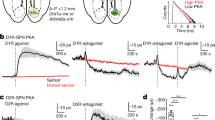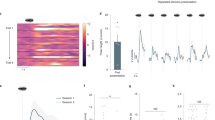The role of dopamine in behavior is in a state of permanent controversy. The notion of ‘prediction error’ is a central component in current reward-based models of learning, but there are many caveats and contradictions in the supporting data. In this paper we propose that the same dopamine signal can both promote an action and reinforce it and we outline a novel model of reward-based learning in which dopamine operates as a teaching signal with DA release starting well before and persisting beyond the action being reinforced. The post-response signal providing the true excitatory drive for long-term potentiation (LTP) comes from the intralaminar nuclei of the thalamus. The main component of this hypothetical mechanism is the direct striatal projection neuron pathway, while there are indications that the indirect pathway is fundamentally able to modulate the direct pathway, thus providing behavioral flexibility.
Similar content being viewed by others
References
Beeler, J. A., “Thorndike’s Law 2.0: Dopamine and the regulation of thrift,” Front. Neurosci., 6, 116 (2012), Doi: 10.3389/fnins.2012. 00116.
Berridge, K. C., “The debate over dopamine’s role in reward: the case for incentive salience,” Psychopharmacology (Berl.), 191, 391–431, (2007).
Cacciapaglia, F., Wightman, R. M., and Carelli, R. M., “Rapid dopamine signaling differentially modulates distinct microcircuits within the nucleus accumbens during sucrose-directed behavior,” J. Neurosci., 3, 13860–13869 (2011).
De Lafuente, V. and Romo, R., “Dopamine neurons code subjective sensory experience and uncertainty of perceptual decisions,” Proc. Natl. Acad. Sci. USA, 108, 19767–19771, (2011).
Ding, J., Peterson, J. D., and Surmeier, D. J., “Corticostriatal and thalamostriatal synapses have distinctive properties,” J. Neurosci., 28, 6483–6492 (2008).
Gerfen, C. R. and Surmeier, D. J., “Modulation of striatal projection systems by dopamine,” Ann. Rev. Neurosci., 34, 441–466 (2011).
Ivlieva, N. Yu., “Involvement of the mesocortico-limbic dopaminergic system in adpative behavior,” Zh. Vyssh. Nerv. Deyat., 60, No. 3, 259–278 (2010).
Kreitzer, A. C., “Physiology and pharmacology of striatal neurons,” Ann. Rev. Neurosci., 32, 127–147 (2009).
McHaffie, J. G., Stanford, T. R., Stein, et al., “Subcortical loops through the basal ganglia,” Trends Neurosci., 28, 401–407 (2005).
Neve, K. A. and Neve, R. L., “Molecular biology of dopamine receptors,” in: The Dopamine Receptors, Neve, K. A. and Neve R. L. (eds.), Humana Press, Totowa, N.J. (1997), pp. 27–76.
Oleson, E. B., Gentry, R. N., Chioma, V. C., and Cheer, J. F., “Subsecond dopamine release in the nucleus accumbens predicts conditioned punishment and its successful avoidance,” J. Neurosci., 32, 14804–14808 (2012).
Puryear, C. B., Kim, M. J., and Mizumori, S. J., “Conjunctive encoding of movement and reward by ventral tegmental area neurons in the freely navigating rodent,” Behav. Neurosci., 124, 234–247, (2010).
Reiner, A., Hart, N. M., Lei, W., and Deng, Y., “Corticostriatal projection neurons – dichotomous types and dichotomous functions,” Front. Neuroanat., 4, 14 (2010), Doi: 10.3389/fnana.2010.00142.
Richfield, E. K., Penney, J. B., and Young, A. B., “Anatomical and affinity state comparisons between dopamine D1 and D2 receptors in the rat central nervous system,” Neuroscience, 30, 767–777 (1989).
Roitman, M. F., Stuber, G. D., Phillips, P. E., et al., “Dopamine operates as a subsecond modulator of food seeking,” J. Neurosci., 24, 1265–1271 (2004).
Salamone, J. D., Correa, M., Farrar, A., and Mingote, S. M., “Effort-related functions of nucleus accumbens dopamine and associated forebrain circuits,” Psychopharmacology (Berl.), 191, 461–482 (2007).
Schultz, W., “Getting formal with dopamine and reward,” Neuron, 36, 241–263 (2002).
Shen, W., Flajolet, M., Greengard, P., and Surmeier, D. J., “Dichotomous dopaminergic control of striatal synaptic plasticity,” Science, 321, 848–851 (2008).
Shuvaev, V. T. and Suvorov, N. F., The Basal Ganglia and Behavior, Nauka, St. Petersburg (2001).
Taverna, S., Ilijic, E., and Surmeier, D. J., “Recurrent collateral connections of striatal medium spiny neurons are disrupted in models of Parkinson’s disease,” J. Neurosci., 28, 5504–5512 (2008).
Thorndike, E., Animal Intelligence: Experimental Studies, Macmillan, New York (1911).
Wassum, K. M., Ostlund, S. B., and Maidment, N. T., “Phasic mesolimbic dopamine signaling precedes and predicts performance of a self-initiated action sequence task,” Biol. Psychiatry, 71, 846–854 (2012).
Wise, R. A., “Dual roles of dopamine in food and drug seeking: The drivereward paradox,” Biol. Psychiatry, (2012), Doi:pii: S0006-3223(12) 00772-X. 10.1016/j.biopsych.2012.09.001.
Wise, R. A. and Bozarth M. A., “Brain mechanisms of drug reward and euphoria,” Psychiatr. Med., 3, 445–460 (1985).
Author information
Authors and Affiliations
Corresponding author
Additional information
Edited from Zhurnal Vysshei Nervnoi Deyatel’nosti imeni I. P. Pavlova, Vol. 64, No. 3, pp. 251–254, May–June, 2014.
Rights and permissions
About this article
Cite this article
Ivlieva, N.Y., Ivliev, D.A. The Specific Role of Dopamine in the Striatum during Operant Learning. Neurosci Behav Physi 46, 73–76 (2016). https://doi.org/10.1007/s11055-015-0200-y
Received:
Accepted:
Published:
Issue Date:
DOI: https://doi.org/10.1007/s11055-015-0200-y




